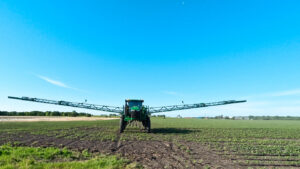A consortium of agriculture industry experts has released a new “Ag Playbook” aimed at helping startups, investors, and others establish a common baseline framework for the product development process for agriculture technologies, including a standardized nomenclature.
Edited by Leaps by Bayer, the playbook is a joint effort between multiple individuals from various companies including Bayer, Oerth Bio, Enko Chem, Citi, Cleveland Avenue Ventures, and several others.
“It’s not just the Leaps by Bayer AG playbook,” Paimun Amini, senior director of venture investments at Leaps by Bayer and editor of the playbook, tells AgFunderNews.
“This is an industry playbook with the goal of raising all tides. Getting these folks from different aspects of industry . . . gives me a feeling of comfort that we’re doing something that can be a nice baseline for the next generation of entrepreneurs to work off of and then iterate forward from.”
The ‘Reverse Field of Dreams’
Currently, there is no shared understanding amongst startups, investors and agribusiness incumbents about what it really takes to bring ag technologies to market, notes the playbook.
“Once a product is finally ready for commercial launch, agtech startups encounter a second problem in trying to scale the solution: it becomes clear that getting onto one, ten, or a hundred million acres is very costly, unless the startup partners with other agricultural companies and retailers.”
As past companies that have tried going directly to the farmer learned, that route is prohibitively expensive and not at all a shoe-in.
“This is the Reverse Field of Dreams scenario,” the playbooks authors write. “If you build it, the market will not necessarily come.”

“There’s still this asymmetric information-sharing amongst different players of the industry about what it really takes to develop products and bring new, novel innovation through R&D and scale [them] up to millions of acres,” says Amini.
Bringing “a little bit more of this standard nomenclature” solves a two-side problem, he adds. On the startup side, companies can gain a better understanding of the milestones they should anticipate, how to budget and what they want to prove out.
Investors could gain a better understanding of ag industry timelines (which are substantially longer than software) and invest accordingly.
Setting a baseline with small molecules
For this first release, the playbook focuses primarily on what it calls “crop protection small molecule products,” a category where in the last 15 years development costs have risen 99% and the path to market has lengthened from 8.3 to 12 years, according to the playbook.
This example “demonstrates the general trend in the industry of increasing cost and time to market” thanks to a mix of safety and regulatory approval processes, testing, reviews and product registrations, among other tasks.
“What we wanted to do with this is bring that transparency of what you have to do to prove out a well-documented product class today,” says Amini, who adds that the group is trying to set a baseline framework that could be applicable to any product.
While there are always differences between products, the playbook lays out a few “consistent truths” in the crop protection space for companies and investors to consider.
- It takes time (4-13 years) to bring any of these products to market.
- It takes significant capital ($50-$400m) to develop agtech products.
- There is a high burden of testing to prove these products will work well within the integrated system of existing agricultural technologies and practices.
- Working with partners and farmers is key to building belief and establishing consumer trust in the market.
Future chapters of the playbook may focus on other forms of crop protection products, crop improvement technologies, biological products, digital ag products, and animal ag products.
What ag can learn from pharma
The crop protection small molecule products category also shares similarities to pharma, which has long had an industry-wide playbook and accompanying nomenclature.
Like crop protection products, pharma products require extensive amounts of time, money, and regulatory hurdles to bring to market.
“Pharma takes even more money to bring to market, usually north of $500 million to develop just one drug candidate and 10 to 13 years as well,” says Amini.
“What’s different [in pharma] is that the number of people who have understood that product life cycle, who’ve worked in developing those products, and the tail-end market for folks who acquire or work with it thereafter, is much larger [than agtech] at this point in time,” he adds.
For example, “You see a lot of these phase two exits that happen in the pharmaceutical industry because you have folks who know what needs to happen to carry [a product] that last mile. You don’t see that happening in our industry as much for two reasons: One, you know, there’s only so many people who play in that later stage side of the market. The second reason is that folks who understand those phases of product development are pretty consolidated, and that information is not as well understood on all sides.”
“There’s this assumption in the biological space today that you don’t have to do as rigorous testing in a number of those categories, but a lot of that is that they’re just not regulated the same way. Like anything else, once it gets big enough, there’s a harder lens cast on [the industry].”




